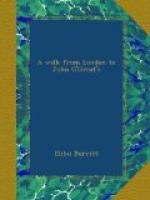It is doubtful if 3,000 acres of land, lying in one solid block, could be found in England better adapted for testing and rewarding the most scientific and expensive processes of agriculture, than this great occupation of Mr. Jonas. Certainly, no equal space could present a less quantity of waste land, or occupy less in hedges or fences. And it is equally certain that no estate of equal size is more highly cultivated, or yields a greater amount of production per acre. Its occupant, also, is what may be called an hereditary farmer. His father and his remote ancestors were farmers, and he, as in the case of the late Mr. Webb, has attained to his present position as an agriculturist by practical farming.
Mr. Jonas cultivates his land on the “Four-course system.” This very term indicates the degree to which English agriculture has been reduced to a precise and rigid science. It means here, that the whole arable extent of his estate is divided equally between four great crops; or, wheat, 750 acres; barley and oats, 750; seeds and pulse, 750; and roots, 750. Now, an American farmer, in order to form an approximate idea of the amount of labor given to the growth of these crops, must remember that all these great fields of wheat, oats, barley, turnips, beans, and peas, containing in all over 2,000 acres, are hoed by hand once or twice. His cereals are all drilled in at seven inches apart, turnips at seventeen. The latter are horse-hoed three or four times; and as they are drilled on the flat, or without ridging the surface of the ground, they are crossed with a horse-hoe with eight V shaped blades. This operation leaves the plants in bunches, which are singled out by a troop of children. One hand-hoeing and two or three more horse-hoeings finish the labor given to their cultivation. It is remarkable what mechanical skill is brought to bear upon these operations. In the first place, the plough cuts a furrow as straight and even as if it were turned by machinery. A kind of esprit de corps animates the ploughmen to a vigorous ambition in the work. They are trained to it with as much singleness of purpose as the smiths of Sheffield are to the forging of penknife blades. On a large estate like that occupied by Mr. Jonas, they constitute an order, not of Odd Fellows, but of Straight Furrow-men, and are jealous of the distinction. When the ground is well prepared, and made as soft, smooth, and even as a garden, the drilling process is performed with a judgement of the eye and skill of hand more marvellous still. The straightness of the lines of verdure which, in a few weeks, mark the tracks of the seed-tubes, is surprising. They are drawn and graded with such precision that, when the plants are at a certain height, a horse-hoe, with eight blades, each wide enough to cut the whole intervening space between two rows, is passed, hoeing four or five drills at once. Of course, if the lines of the drill and hoe did not exactly correspond with each other, whole rows of turnips would be cut up and destroyed. I saw this process going on in a turnip field, and thought it the most skilful operation connected with agriculture that I had ever witnessed.




